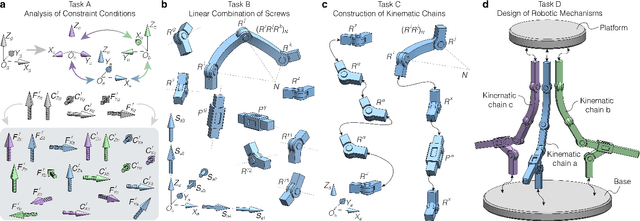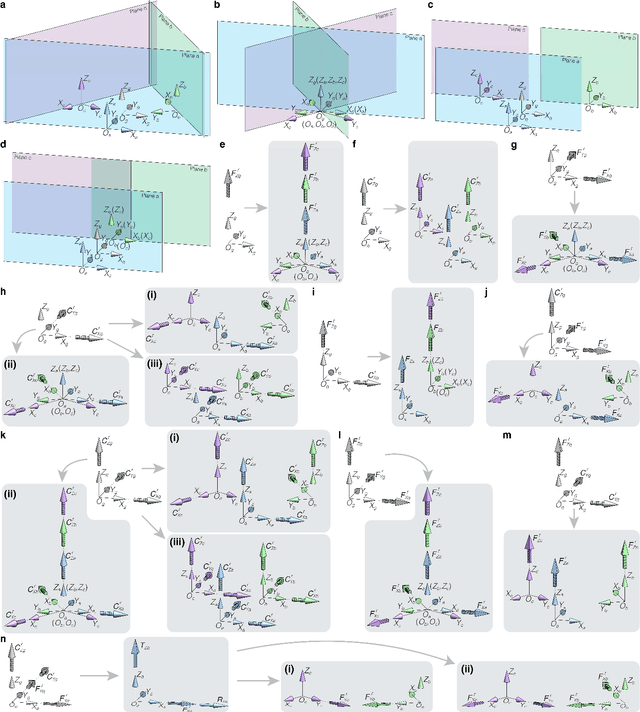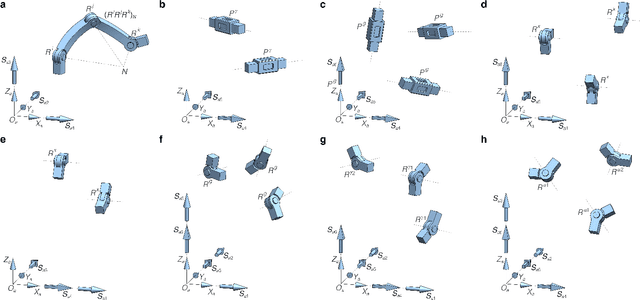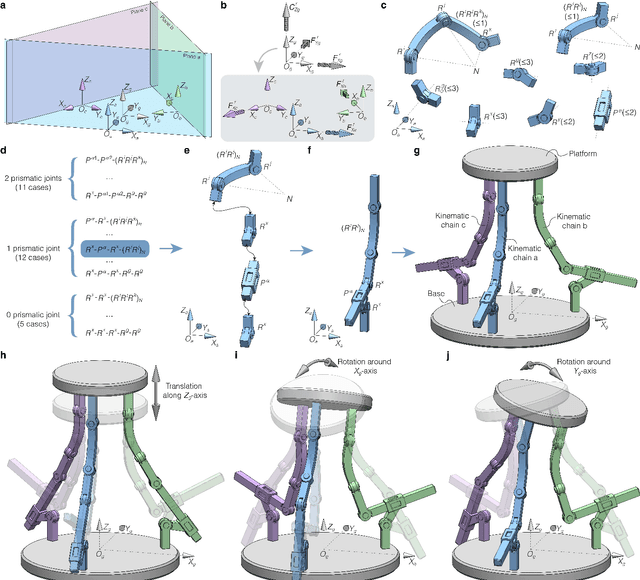Ceng Zhang
INGRID: Intelligent Generative Robotic Design Using Large Language Models
Sep 04, 2025



Abstract:The integration of large language models (LLMs) into robotic systems has accelerated progress in embodied artificial intelligence, yet current approaches remain constrained by existing robotic architectures, particularly serial mechanisms. This hardware dependency fundamentally limits the scope of robotic intelligence. Here, we present INGRID (Intelligent Generative Robotic Design), a framework that enables the automated design of parallel robotic mechanisms through deep integration with reciprocal screw theory and kinematic synthesis methods. We decompose the design challenge into four progressive tasks: constraint analysis, kinematic joint generation, chain construction, and complete mechanism design. INGRID demonstrates the ability to generate novel parallel mechanisms with both fixed and variable mobility, discovering kinematic configurations not previously documented in the literature. We validate our approach through three case studies demonstrating how INGRID assists users in designing task-specific parallel robots based on desired mobility requirements. By bridging the gap between mechanism theory and machine learning, INGRID enables researchers without specialized robotics training to create custom parallel mechanisms, thereby decoupling advances in robotic intelligence from hardware constraints. This work establishes a foundation for mechanism intelligence, where AI systems actively design robotic hardware, potentially transforming the development of embodied AI systems.
Origami-Inspired Soft Gripper with Tunable Constant Force Output
Mar 03, 2025Abstract:Soft robotic grippers gently and safely manipulate delicate objects due to their inherent adaptability and softness. Limited by insufficient stiffness and imprecise force control, conventional soft grippers are not suitable for applications that require stable grasping force. In this work, we propose a soft gripper that utilizes an origami-inspired structure to achieve tunable constant force output over a wide strain range. The geometry of each taper panel is established to provide necessary parameters such as protrusion distance, taper angle, and crease thickness required for 3D modeling and FEA analysis. Simulations and experiments show that by optimizing these parameters, our design can achieve a tunable constant force output. Moreover, the origami-inspired soft gripper dynamically adapts to different shapes while preventing excessive forces, with potential applications in logistics, manufacturing, and other industrial settings that require stable and adaptive operations
RAIL: Robot Affordance Imagination with Large Language Models
Mar 28, 2024Abstract:This paper introduces an automatic affordance reasoning paradigm tailored to minimal semantic inputs, addressing the critical challenges of classifying and manipulating unseen classes of objects in household settings. Inspired by human cognitive processes, our method integrates generative language models and physics-based simulators to foster analytical thinking and creative imagination of novel affordances. Structured with a tripartite framework consisting of analysis, imagination, and evaluation, our system "analyzes" the requested affordance names into interaction-based definitions, "imagines" the virtual scenarios, and "evaluates" the object affordance. If an object is recognized as possessing the requested affordance, our method also predicts the optimal pose for such functionality, and how a potential user can interact with it. Tuned on only a few synthetic examples across 3 affordance classes, our pipeline achieves a very high success rate on affordance classification and functional pose prediction of 8 classes of novel objects, outperforming learning-based baselines. Validation through real robot manipulating experiments demonstrates the practical applicability of the imagined user interaction, showcasing the system's ability to independently conceptualize unseen affordances and interact with new objects and scenarios in everyday settings.
Integration of Large Language Models in Control of EHD Pumps for Precise Color Synthesis
Jan 21, 2024
Abstract:This paper presents an innovative approach to integrating Large Language Models (LLMs) with Arduino-controlled Electrohydrodynamic (EHD) pumps for precise color synthesis in automation systems. We propose a novel framework that employs fine-tuned LLMs to interpret natural language commands and convert them into specific operational instructions for EHD pump control. This approach aims to enhance user interaction with complex hardware systems, making it more intuitive and efficient. The methodology involves four key steps: fine-tuning the language model with a dataset of color specifications and corresponding Arduino code, developing a natural language processing interface, translating user inputs into executable Arduino code, and controlling EHD pumps for accurate color mixing. Conceptual experiment results, based on theoretical assumptions, indicate a high potential for accurate color synthesis, efficient language model interpretation, and reliable EHD pump operation. This research extends the application of LLMs beyond text-based tasks, demonstrating their potential in industrial automation and control systems. While highlighting the limitations and the need for real-world testing, this study opens new avenues for AI applications in physical system control and sets a foundation for future advancements in AI-driven automation technologies.
 Add to Chrome
Add to Chrome Add to Firefox
Add to Firefox Add to Edge
Add to Edge